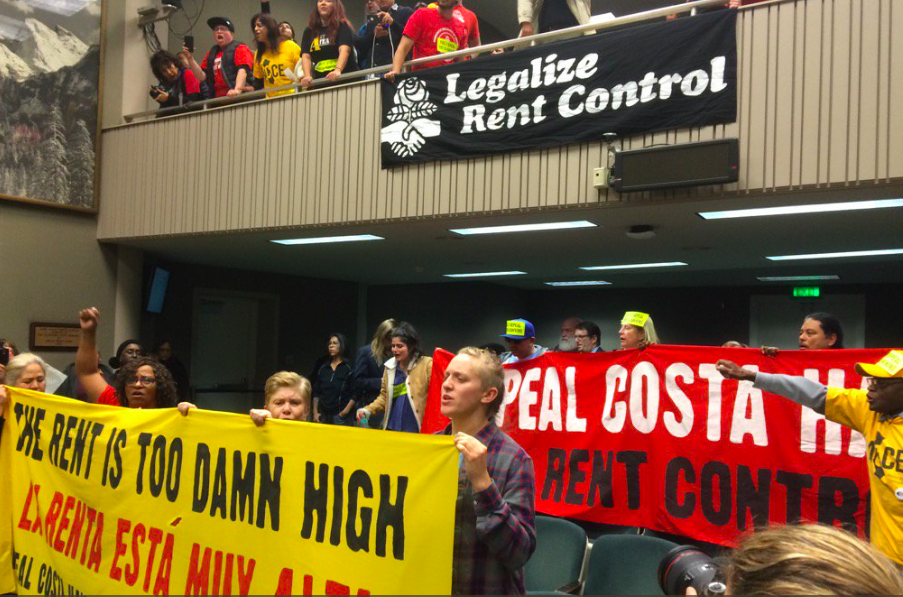The Board of Supes Land Use and Transportation Committee held an historic hearing today, focusing on a report by labor and affordable housing activists, and one clear message came out:
Relying on the private market to solve the housing crisis has been and will continue to be a complete failure.
Labor groups, particularly the building trades, have often in the past clashed with neighborhood activists fighting to prevent displacement, since the trades typically support almost any housing development that creates union jobs.

But in this case, labor groups, including the building trades, worked with the Council of Community Housing Organizations on a landmark report addressing the city’s jobs-housing balance.
Just the fact that a board hearing focused not on a housing report from city planners but from a community-based organization is a pretty dramatic step. The report takes a clear stand:
Unaffordable housing costs are not an accident – the housing affordability crisis is the outcome of a real estate industry that has created the conditions for the gentrification of San Francisco’s working-class neighborhoods, and of the complicity of local public policy in allowing and even incentivizing this speculative behavior.
Speaker after speaker noted that existing housing policy has driven even relatively well-paid union members out of town. At this point, the report shows, 40 percent of the city’s workforce doesn’t live in San Francisco.
“Policy makers who rush to follow the failed policies of trickle-down housing have to do something different,” Sup. Dean Preston said.
This discussion, which so far has been almost entirely missing from the Chron and the other news outlets that love the Yimby’s market-based solutions, is essential: The city is preparing a new Housing Element to the General Plan, the state is trying to push new mandates on cities to allow more market-rate development, and a key issue in a looming state Assembly campaign will be local housing programs.
Two of the three leading candidates for the seat vacated by David Chiu, who is now the city attorney, have cast their lot with the Yimbys. Sup. Matt Haney voted in favor of a project that many Soma advocates said would lead to gentrification and displacement. Community College Board Member Thea Selby told me recently that she is a big fan of allowing developers to build more market-rate housing and has supported State Sen. Scott Wiener’s bills putting mandates on cities to allow more housing.
Former Sup. David Campos has made it clear he does not support the Yimby agenda and was not a fan of the 469 Stevenson Street project:
This community includes one of the few remaining Filipino-American communities in San Francisco, and Filipino leaders have spoken out again and again against the project because they know it will lead to displacement.
The proposal is described by proponents as housing in a former parking lot. But that parking lot is in a neighborhood — a community teetering on the edge of displacement. Of the proposed development, only 14.7 percent of the on-site units are affordable — meaning 85 percent will be luxury housing in a luxury high-rise. Yes, there is a promise of additional fees to fund additional off-site units, but that is not a guarantee of homes. Of the few affordable homes actually included in the project, just 40 percent are reserved for people from San Francisco — meaning less than 6 percent of the units could possibly help house the working people of our city.
That’s not good enough. And that’s just a fraction of the percentage of affordable housing negotiated by the former supervisor from District 6, Jane Kim, who routinely secured between 40 and 50 percent affordable housing in new projects in that same neighborhood.
Peter Cohen, co-director of CCHO, said that housing policy needs to start not with the goal of more luxury units but with the “three P’s:” Protection, Preservation, and Production.
As the report notes,
To truly provide housing stability and long-term security for workers such as those featured in this report, in proximity to their workplaces, depends on solutions that de-emphasize land and housing as commodities, that support housing production that is needs-based rather than simply market-based, and that reduce incentives for speculation with a goal to achieve a jobs-housing fit.
The first two are often left out of the Yimby approach. In a housing crisis, the most valuable housing is the existing stock of rent-controlled units—and anything that threatens the existing residents of those units has to be considered the most serious problem.
More from the report:
A starting point for a Housing our Workers approach is to begin by protecting low- and moderate-income tenants and homeowners facing financial distress and potential displacement from their homes because of loss of income or employment from eviction, debt, and foreclosure crisis.
That means more efforts on both the state and local level to keep working-class residents who live here now from being forced out. Wiener, for example, could have linked his pro-developer laws to a repeal of the Ellis Act and Costa-Hawkins; tell the real-estate industry you get both or you get neither.
He didn’t do that.
And then there’s Production. From the report:
San Francisco is extremely “out of whack” in its Jobs-Housing Fit. What is needed are BIG solutions at the true scale of the problem–land and funding sufficient to meet actual need. Just to meet San Francisco’s own official goals, as set out in its General Plan Housing Element, the city should be building 2,000 new affordable units annually, dedicating about 15-20 new sites to affordable housing each year. This would mean basically tripling the City’s annual affordable housing investment.
This is the discussion that the Chron and the Yimbys need to hear. The city’s approved a huge amount of luxury housing in the past decade; prices haven’t come down.
And now the supes are seriously looking at another approach.



